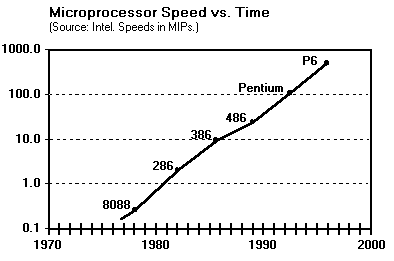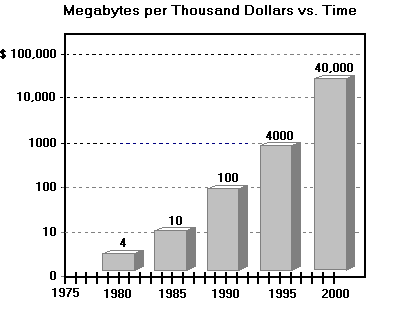
Technology advances and the wide adoption of computing have had some surprising results. Today, commodity (Intel-based) components are the fastest and most reliable computers, networks, and storage devices. The intense competition among microprocessor vendors has created incredibly fast processing chips. Indeed, the most powerful supercomputers are built from such chips. Conventional water-cooled mainframes are moving to this higher-speed technology.
Commodity workstations and servers rival and often outstrip the performance of mainframes. The pace of change in this commodity market is so rapid that the "low end" is years ahead of the installed base of conventional mainframe and minicomputer architectures. The following illustration shows the astonishing speedup of microprocessors over time.

Commodity computer interconnects are also making extraordinary progress. Ethernet has graduated to 12 megabyte per second (MB/sec) speeds. Switched 100 MB/sec Ethernet gives a hundredfold speedup in local networks at commodity prices. Asynchronous Transfer Mode (ATM) hardware will soon be ubiquitous for both local and wide area networks. ATM offers a tenfold increase over switched Ethernet.
The entire computer industry uses the same basic 16-megabit DRAM chips that are used in personal computers. Memory prices for commodity computers are often three to ten times less than the price of the same memory for a proprietary (manufacturer-specific) computer.
In terms of performance and reliability, the best disks are 3.5-inch SCSI disks. They have doubled in capacity every year and are rated at a 50-year interval to hardware failure. Today, the 4 GB disk is standard. The following illustration shows that in 1995, a 4 GB disk cost $1,000.

This is a thousandfold improvement over disks of 15 years ago. These low prices explain why typical servers are configured with 10 GB to 100 GB of disk capacity today. Such disks cost $2,000 to $20,000.